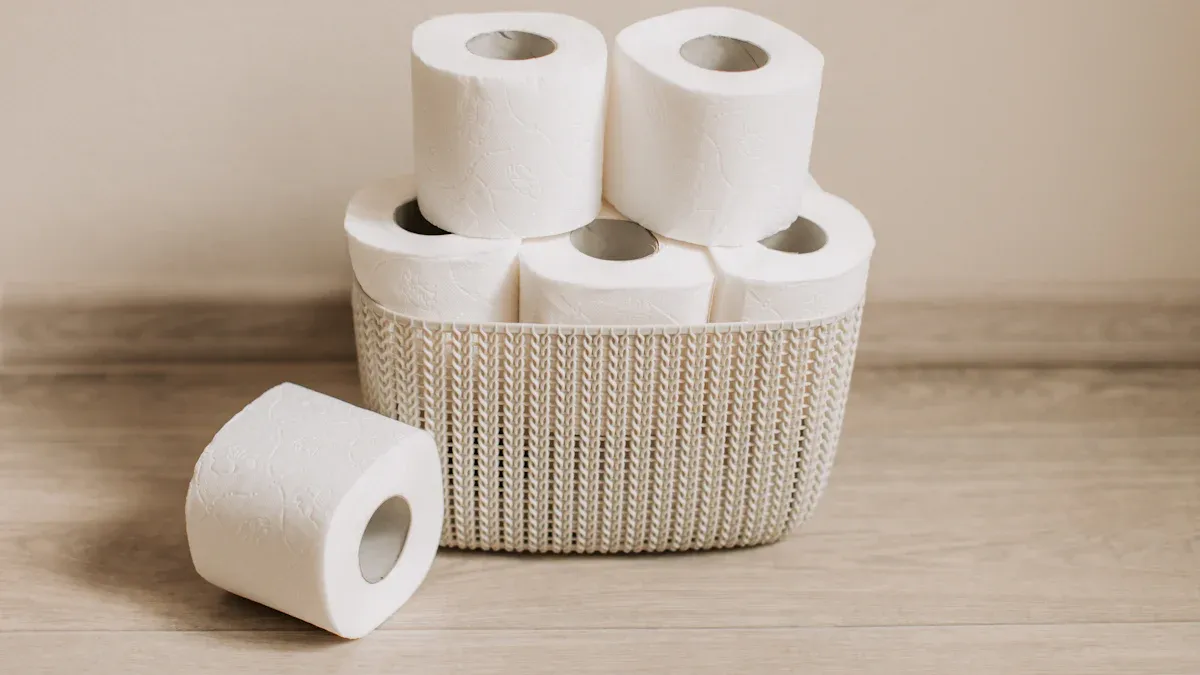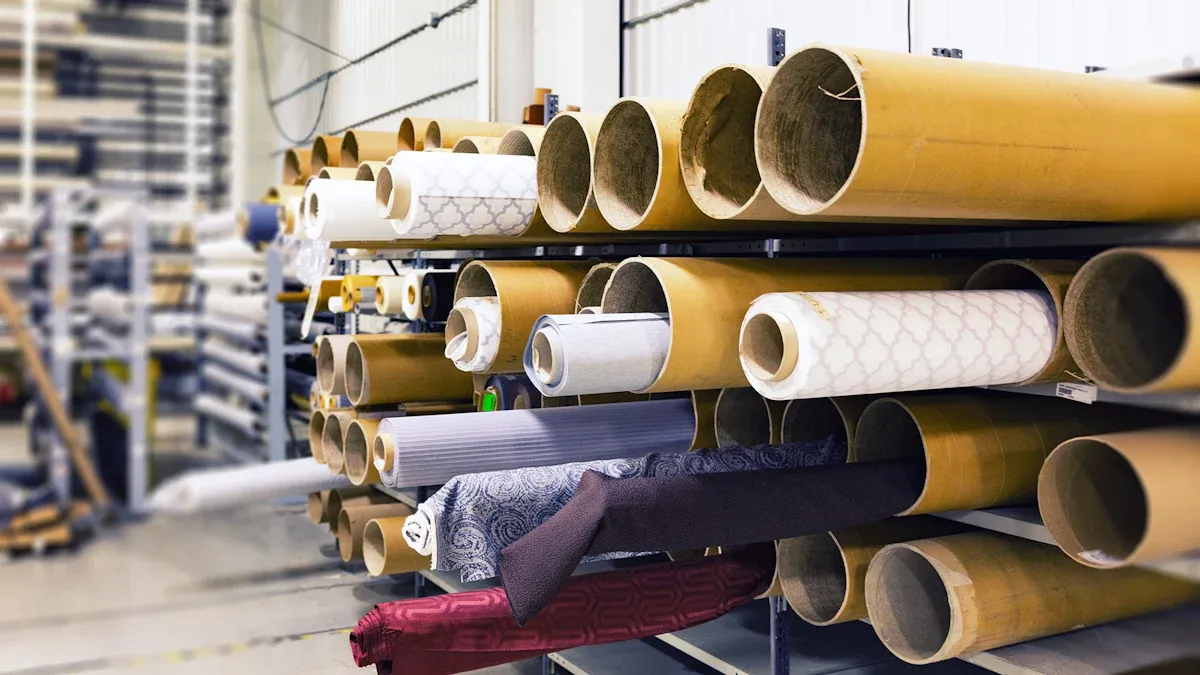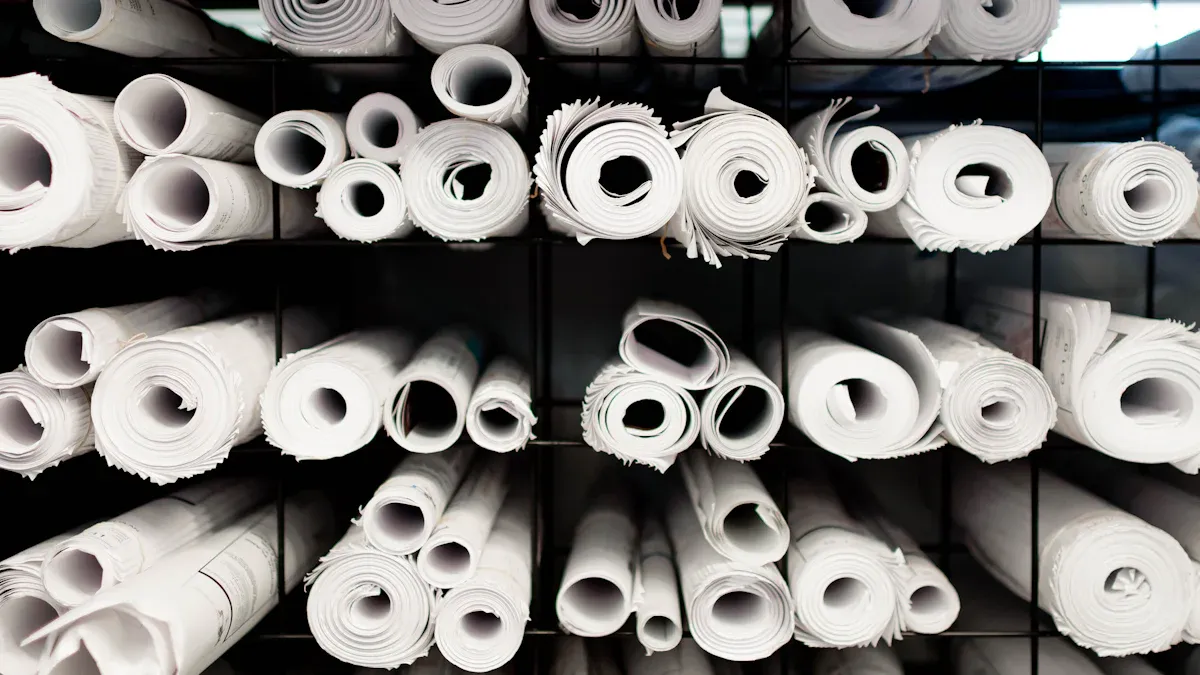
Choosing the appropriate paper tissue mother reels is essential for seamless production and superior product quality. Critical factors such as web width, basis weight, and density play a significant role in determining performance. For instance, maintaining these attributes during the rewinding process ensures customer satisfaction. Companies that opt for the right jumbo tissue roll for toilet paper or paper rolls toilet paper parent roll can streamline operations and effectively meet market demands. Additionally, selecting a high-quality parent paper tissue roll contributes to consistent and reliable output.
Understanding Equipment Compatibility for Paper Tissue Mother Reels

Key Dimensions to Consider: Width, Diameter, and Core Size
Selecting paper tissue mother reels that match equipment specifications begins with understanding critical dimensions. These include the width, diameter, and core size of the reels. Each dimension directly impacts the compatibility and efficiency of converting equipment.
| Dimension Type | Measurement |
|---|---|
| Width of jumbo roll paper | 180-210 mm |
| Diameter of jumbo roll paper | Max. 1500 mm |
| Diameter of jumbo roll paper inner core | 76 mm |
The width of the jumbo roll paper must align with the machine’s cutting and rewinding capabilities. A mismatch can lead to uneven cuts or wasted material. Similarly, the reel’s diameter and core size must fit the machine’s loading and unwinding mechanisms. Machines designed for a 76 mm core, for instance, cannot accommodate reels with larger or smaller cores without modifications.
By adhering to these dimensions, manufacturers can ensure smooth operations and minimize downtime caused by reel incompatibility.
Material Compatibility with Converting Equipment
The material composition of paper tissue mother reels plays a pivotal role in equipment performance. Converting equipment is often calibrated to handle specific types of paper, such as virgin pulp, recycled pulp, or a blend of both. Using incompatible materials can lead to issues like tearing, jamming, or uneven rewinding.
Manufacturers should evaluate the tensile strength, basis weight, and absorbency of the reels to ensure they meet the machine’s operational requirements. For example, high-speed machines may require reels with greater tensile strength to withstand the stress of rapid unwinding. Additionally, the material’s softness and texture must align with the desired end product, whether it is toilet paper, facial tissue, or paper towels.
Regular audits and testing of materials can help identify potential issues before they disrupt production. This proactive approach ensures that the reels not only match the equipment but also meet quality standards.
Machine Speed and Reel Performance Alignment
Machine speed significantly influences the performance of paper tissue mother reels. High-speed machines demand reels that can maintain structural integrity and consistent unwinding under intense operational conditions.
| Machine Model | Design Speed (m/min) | Width at Reel (m) |
|---|---|---|
| PrimeLine S 2200 | 2,200 | 2.6 to 2.85 |
| PrimeLine W 2200 | 2,200 | 5.4 to 5.6 |
Günter Offenbacher, ANDRITZ Sales Director for Tissue and Drying, explains: “Based on our long-term experience and proven expertise in tissue machines, the design of the new machines has been updated with the latest technologies. With the new high-speed machines, we can offer an innovative concept for dry-crepe tissue machines with high production efficiency for every customer need.”
To optimize reel performance, manufacturers can leverage tools like Valmet Machine Diagnostics. These tools provide insights into machine performance, helping to avoid unplanned stops. Regular audits and benchmarking also enable tissue makers to measure and improve production efficiency.
Many tissue producers operate below 80% of their efficiency potential. By addressing issues like web breaks and runnability, mills can increase production capacity without additional investments. Aligning reel performance with machine speed ensures that operations remain efficient and cost-effective.
Evaluating Quality and Market Fit
Importance of Pulp Quality in Tissue Production
High-quality pulp forms the foundation of superior paper tissue mother reels. Manufacturers prioritize pulp attributes like fiber dimensions, strength properties, and brightness to ensure optimal tissue performance.
| Quality Parameter | Description |
|---|---|
| Fiber Dimensions | Key factors like Runkel ratio and slenderness ratio influence pulp quality and paper strength. |
| Runkel Ratio | A low Runkel ratio indicates thin fiber walls, desirable for high-quality paper. |
| Slenderness Ratio | A slenderness ratio below 70 is unsuitable for good-quality pulp and paper production. |
| Strength Properties | Fiber length positively correlates with burst, tensile, and tear strength of the paper. |
| Opacity | Paper from flax straw has an opacity of 92%, ideal for printing applications. |
| Brightness | Brightness level of 86% ISO contributes to high visibility of printed text. |
| Tensile Strength | A tensile strength of 75 N/m ensures durability and resistance to tearing. |
| Burst Strength | Burst strength of 320 kPa reflects the robustness of the paper. |
Fiber dimensions, such as the Runkel ratio, directly impact tissue softness and durability. Thin fiber walls enhance pliability, while longer fibers improve tensile and burst strength. Brightness and opacity further contribute to the aesthetic appeal of the final product. Manufacturers who focus on these parameters produce reels that meet both functional and visual standards.
Softness, Strength, and Absorbency as Key Quality Metrics
Softness, strength, and absorbency define the usability and consumer satisfaction of tissue products. Research highlights the role of raw material optimization and advanced additives like micro/nano-fibrillated cellulose (MNFC) in enhancing these properties.
| Study Focus | Key Findings | Properties Affected |
|---|---|---|
| Tissue Paper Production Research Articles | Optimization of raw materials improves softness, strength, and absorbency. | Softness, Strength, Absorbency |
| Micro/nano-fibrillated cellulose as an additive | Enhances strength while affecting softness and absorbency. | Softness, Strength, Absorbency |
| Comparative study of MNFC | MNFC enhances strength but reduces absorbency and softness. | Softness, Strength, Absorbency |
Softness ensures comfort during use, while strength prevents tearing under pressure. Absorbency enhances the tissue’s effectiveness for cleaning and drying. Manufacturers balance these metrics by selecting appropriate pulp types and additives. For instance, MNFC improves tensile strength but may slightly reduce softness and absorbency. By fine-tuning production processes, companies can achieve the ideal balance for their target market.
Aligning Reels with Consumer Preferences and Brand Positioning
Consumer preferences shape the design and functionality of tissue products. Features like engraved rollers, enhanced absorbency, and customization options allow manufacturers to align their reels with market demands.
| Feature | Description | Benefit |
|---|---|---|
| Engraved Rollers | Create specific patterns and textures | Enhanced aesthetic appeal |
| Precision Controls | Fine-tune embossing operations | Consistent product quality |
| Interchangeable Rollers | Easily switch designs for customization | Market adaptability |
| Enhanced Absorbency | Increases tissue effectiveness for cleaning | Functional improvement |
| Improved Bulk | Adds volume to tissue products | Perceived higher quality |
- Laminators improve structural integrity, producing durable multi-ply tissues.
- Calenders adjust softness and gloss, aligning product attributes with consumer expectations.
- Customization Options include embossing patterns and coreless rolls, catering to diverse market needs.
The tissue paper converting machine market is projected to grow significantly, driven by sustainability trends and evolving consumer demands. Manufacturers who invest in innovative features and eco-friendly practices position their brands as industry leaders. By aligning paper tissue mother reels with these preferences, companies enhance their market competitiveness and customer loyalty.
Cost, Logistics, and Sustainability

Balancing Cost-Effectiveness with Quality
Balancing cost-effectiveness with quality is a critical consideration for manufacturers of paper tissue mother reels. The tissue market has shifted toward local production and self-sufficiency, driving the need for innovative cost optimization strategies. Technological advancements in converting machinery have enabled manufacturers to meet diverse quality demands across economy, standard, and premium segments.
Premium tissue products are gaining popularity in mature markets, emphasizing the importance of quality in maintaining competitiveness. Manufacturers can achieve this balance by investing in efficient machinery and optimizing raw material usage. For example, selecting high-quality pulp ensures superior product performance while minimizing waste during production. By focusing on operational efficiency and strategic resource allocation, companies can reduce costs without compromising product standards.
Storage, Handling, and Transportation Considerations
Proper storage, handling, and transportation of paper tissue mother reels are essential for maintaining their integrity and ensuring smooth operations. Reels must be stored in controlled environments to prevent damage from moisture, dust, or temperature fluctuations. Warehouses equipped with climate control systems can help preserve the quality of the reels.
Handling practices should prioritize safety and efficiency. Using specialized equipment like reel lifters and conveyors minimizes the risk of damage during movement. Transportation logistics must account for reel dimensions and weight to ensure secure loading and unloading. Partnering with reliable logistics providers can streamline delivery processes and reduce delays.
Eco-Friendly Options and Certifications to Look For
Sustainability has become a key focus in the tissue industry. Manufacturers increasingly offer eco-friendly paper tissue mother reels to meet consumer demand for environmentally responsible products. These reels often feature certifications such as FSC (Forest Stewardship Council) and PEFC (Programme for the Endorsement of Forest Certification), which guarantee sustainable sourcing practices.
Recycled pulp and biodegradable materials are popular choices for eco-conscious production. Companies can also adopt energy-efficient manufacturing processes to reduce their carbon footprint. By prioritizing sustainability, manufacturers not only contribute to environmental preservation but also enhance their brand reputation among eco-aware consumers.
Selecting the right paper tissue mother reels ensures smooth operations, superior product quality, and alignment with market demands. Manufacturers benefit from reels that match equipment specifications, meet consumer preferences, and support sustainability goals.
Post time: May-21-2025
